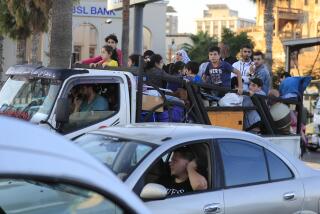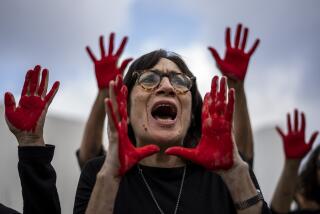Uprising enters crucial phase
In the video, two camouflage-clad rebel fighters crouch behind a dumpster firing their rifles as cars drive by at casual, everyday speeds. In the distance, impatient drivers honk as if the revolution had not arrived on this street in southern Damascus.
But if last weekâs surge of fighting and dramatic strike against the countryâs military command surprised the residents of the Syrian capital, none may have been more shocked than the rebels themselves.
They now face the daunting prospect of seizing a city that for the length of the Syrian uprising has been under a veneer of normality as the rest of the country broke out into an armed insurrection. In Aleppo, the countryâs second-largest city and commercial hub, clashes occurred in several neighborhoods late Friday and continued Saturday.
After the bombing Wednesday that killed four of President Bashar Assadâs top military officials, the uprising has entered a crucial phase. But some question just how prepared the rebels are to sustain an onslaught against the army, security forces and shabiha militia members in the face of enduring challenges such as a shortage of weapons and a lack of unity among scores of armed opposition groups.
âThe Free Syrian Army is moving quickly and well,â said Moaz Shami, a leading activist in the capital. âBut the road ahead is still long, and what the rebels did surpassed their abilities. I canât say that they will liberate Damascus.â
Throughout much of the uprising, rebels with the Free Syrian Army, made up of army defectors and civilian volunteers, have been able to push regime forces out of areas, but they often donât have the ability to maintain control, especially when government forces come back with tanks, armored vehicles and attack helicopters.
On Friday, rebels made what they described as a tactical withdrawal from Damascusâ Midan neighborhood, though they soon returned and clashed with security forces again.
Similarly, on Thursday, rebel fighters stormed the Bab Hawa crossing at the Turkish border -- a strategic point in Idlib province -- and for hours walked around as if they owned it, making videos proclaiming their control and smashing photos of Assad and his late father and predecessor, Hafez Assad. Then, as the army began shelling, they withdrew. A day later there were reports that the rebels had retaken the crossing.
Echoing the sentiments of the more cautious activists and observers, Ammar Abdulhamid, a U.S.-based Syrian human rights activist and fellow at the Foundation for Defense of Democracies, wrote in a daily roundup last week, âSomething is definitely looming in Syria, but itâs not end game. Itâs more like the end of Round One.â
But if the rebels face obstacles in the coming fight, it appears that the government does too. The army was already stretched thin before repositioning forces in Damascus and Aleppo, and rebels say the events of the last week have sped up army defections.
The escalation began Sunday, when government forces began shelling the southern neighborhood of Tadamon, which had been under rebel control for more than a month.
The Free Syrian Army rebels had been making small and targeted attacks but were still building up to a larger offensive when the shelling compelled them to fight before they were fully prepared, said Jacob Hosein, the alias of a spokesman in Tadamon for the Local Coordination Committees, an opposition activist coalition.
âThey were forced into it; the Free Syrian Army was not planning to do it like that,â he said. âIt was the regimeâs choice to push this -- we have a saying, âWe will eat them for lunch before they eat us for dinner.â â
The Assad government assumed that if it shelled Tadamon, that would be an example for the rest of the city and it would fall into line, but the opposite happened, Hosein said.
âThe grip of the regime over Syria is loosened now, more and more,â he said. âHopefully even if the regime doesnât fall down [by Eid al-Fitr, the end of the monthlong Ramadan season that began Friday], itâs going to be weaker and weaker.â
Still, the amount of resources the Assad government has turned on Damascus poses a challenge to the outgunned rebels, said Amr Azm, an opposition activist who is involved with the Syrian National Council, the leading opposition bloc, which is based in Turkey. Unlike Aleppo, which has been building up to an offensive slowly and is closer to supply lines of weapons and humanitarian aid, Damascus is more isolated, he said.
âI think itâs going to cause more problems and use up resources that they were building up for a big push,â he said. âThat being said, it will have a huge impact.... It will strike at the narrative of the regime that it is spinning out, that âIâm going to survive, that Iâm going to win this.â â
For months, rebel militias from surrounding suburbs and towns in nearby Homs province have been sending members to the capital to prepare for just such a face-off. But as the fighting intensifies, it also runs the risk of stripping too many fighters from other areas and possibly leaving them vulnerable, he said.
As the fighting continues in Damascus, there are also reports that the government has withdrawn troops from the border of the disputed Golan Heights, held by Israel, and moved them to the capital.
In Aleppo, opposition fighters had been taking a more gradual approach before Fridayâs clashes. For more than a month they have been staging small attacks on businesses and vehicles of suspected shabiha members and the more than 80 checkpoints in the city.
Col. Abduljabar Aqidi, who defected from the army in March and heads the revolutionary council for Aleppo, said tanks were positioned in the city but rebels have been able to exert control in some areas.
âThe Free Syrian Army is protecting the protests, which are coming out in large numbers, and the FSA is able to move freely in certain neighborhoods,â Aqidi said. âThat is a huge accomplishment.â
Despite small successes such as this one for the opposition, the rebel ranks in Aleppo remain divided, unorganized and grossly outnumbered.
âIf the army comes in to retake it, we have no way to defend it,â said Abo Adel, an activist in the city. âAs soon as an area gets liberated, it gets shelled. Just like what happened in all the cities, just like what happened in Baba Amr,â the shattered Homs neighborhood.
As hostilities in Aleppo grow, the potential casualties are a great concern because civilians from surrounding suburbs and provinces have fled to the city, ballooning its population. Some estimate it now has 9 million residents.
âI think itâs still a long road ahead,â Adel said. âWe are working long-term. We know itâs not going to end by Eid.â
More to Read
Sign up for Essential California
The most important California stories and recommendations in your inbox every morning.
You may occasionally receive promotional content from the Los Angeles Times.









